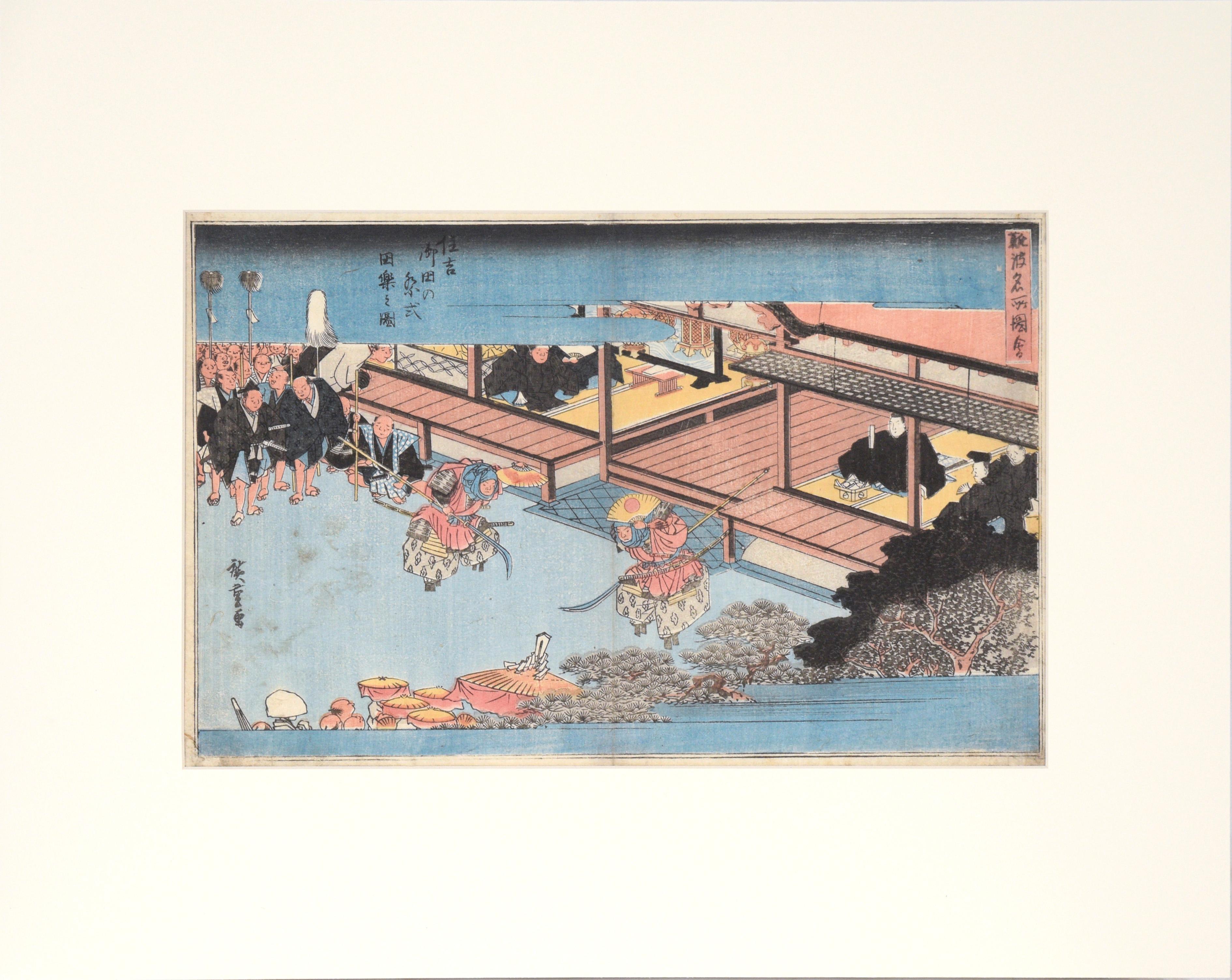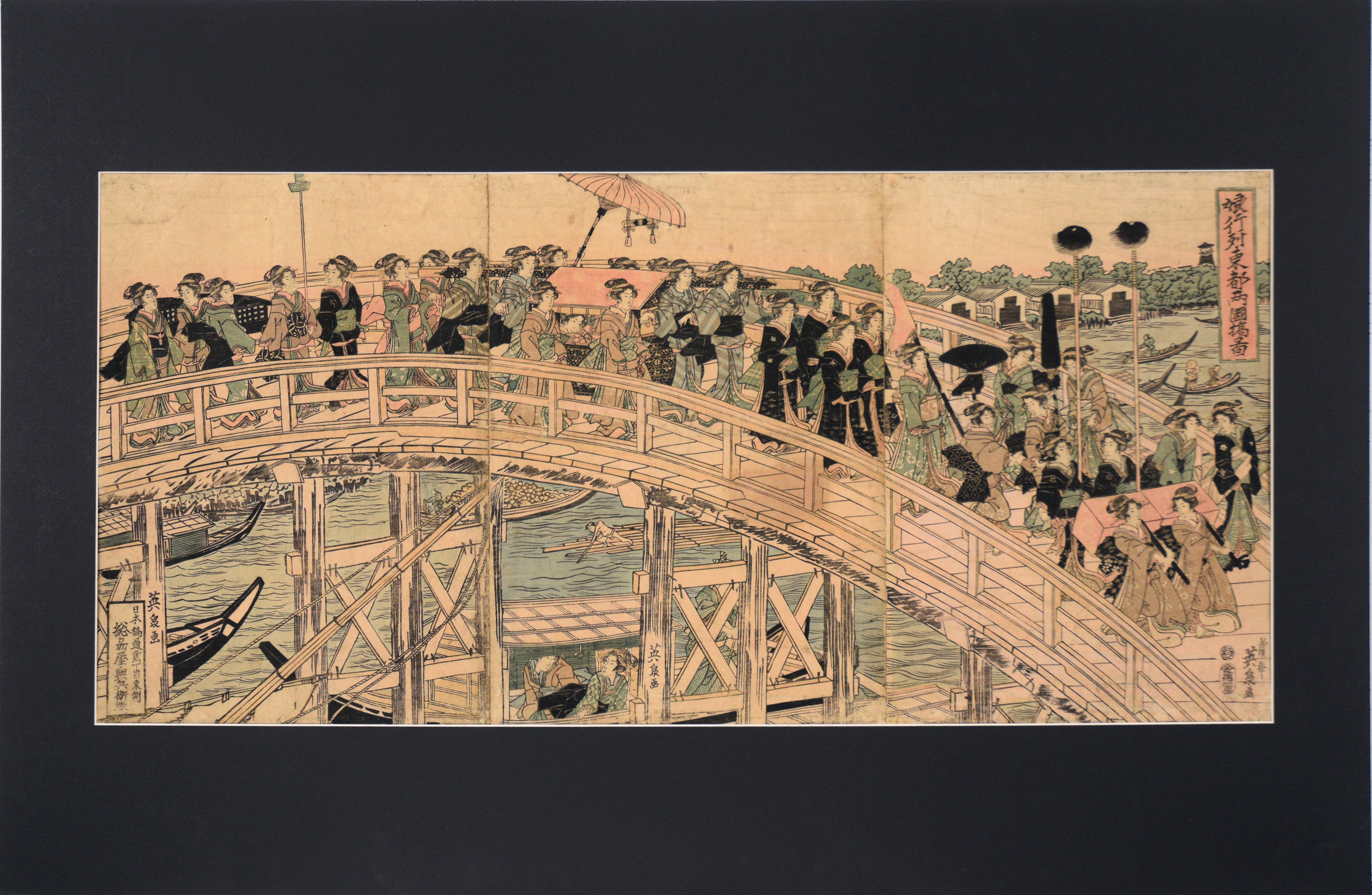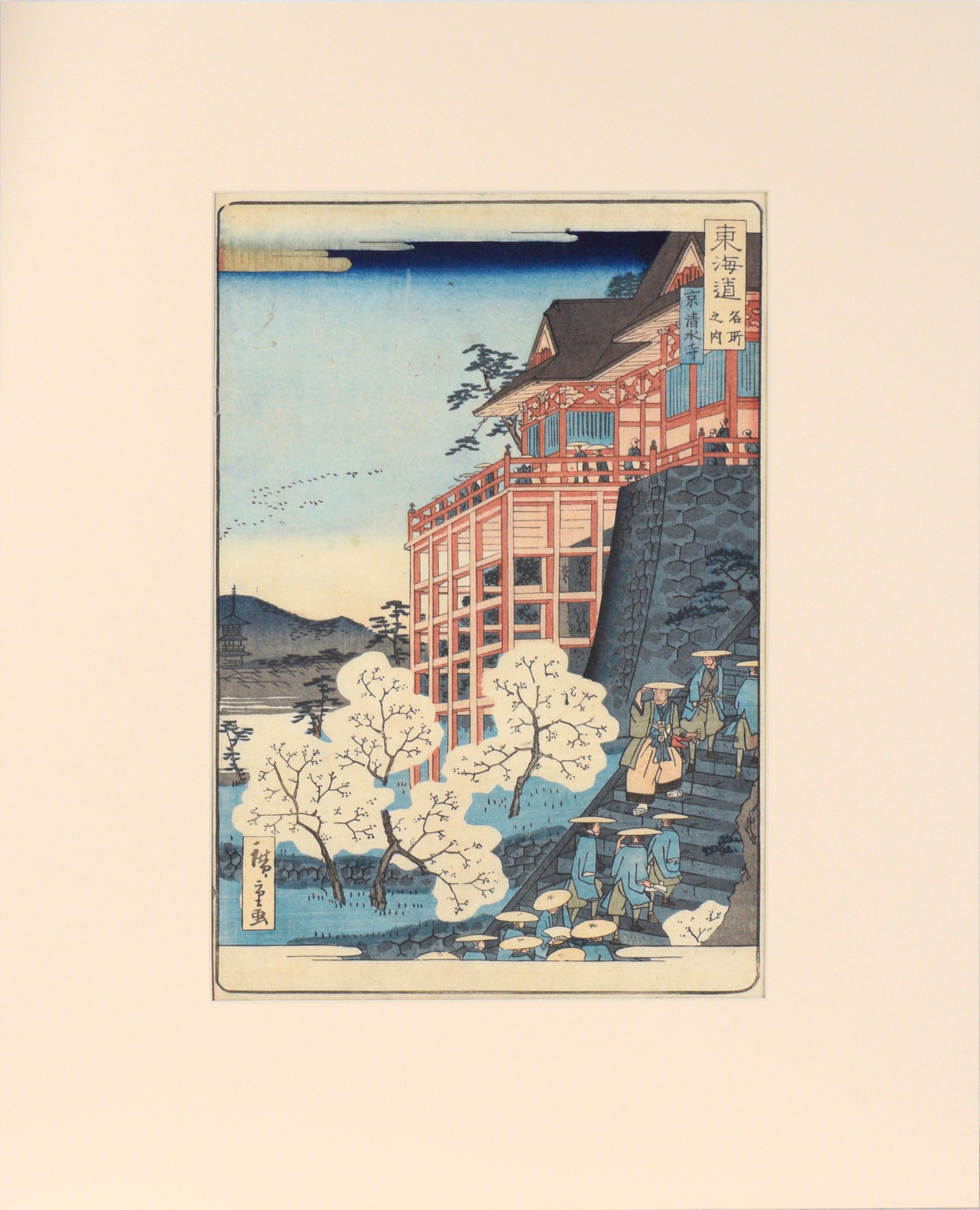Items Similar to Festival Procession Of A Daimyo - Original Woodblock Print
Want more images or videos?
Request additional images or videos from the seller
1 of 6
UnknownFestival Procession Of A Daimyo - Original Woodblock Print18th Century
18th Century
About the Item
Procession Of A Daimyo - Original Woodblock Print
Original woodblock print depicting the procession of a Daimyo. Ten Japanese soldiers are seen as they aid in transporting the Daimyo. Daimyo were powerful Japanese magnates, feudal lords who, from the 10th century to the early Meiji period in the middle 19th century, ruled most of Japan from their vast, hereditary land holdings. The soldiers are seen carrying weapons, ceremonial accoutrements, and personal effects.
Unframed. Protected by glass, edged in tape.
Image: 9"H x 18"W
During the Edo period, on a biannual basis, Daimyo were required to travel to Edo, where the Tokugawa shogunate had been based since the early seventeenth century, and take up residence there under the sankin kōtai (alternate attendance) system. Hundreds of retainers are shown transporting weapons, ceremonial accoutrements, and personal effects that bespeak the Daimyo’s military and financial might. Some are mounted on horses; the Daimyo and certain other members of his family are carried in palanquins.
- Creation Year:18th Century
- Dimensions:Height: 9 in (22.86 cm)Width: 18 in (45.72 cm)Depth: 0.5 in (1.27 cm)
- Medium:
- Movement & Style:
- Period:
- Condition:Normal age toning to paper.
- Gallery Location:Soquel, CA
- Reference Number:
About the Seller
4.9
Platinum Seller
These expertly vetted sellers are 1stDibs' most experienced sellers and are rated highest by our customers.
Established in 1986
1stDibs seller since 2014
2,536 sales on 1stDibs
Typical response time: <1 hour
- ShippingRetrieving quote...Ships From: Soquel, CA
- Return PolicyA return for this item may be initiated within 14 days of delivery.
More From This SellerView All
- Sumiyoshi: Dengaku dance performed during an Onda ceremony - Woodblock PrintBy Utagawa HiroshigeLocated in Soquel, CASumiyoshi: Dengaku dance performed during an Onda ceremony - Woodblock Print Bright woodblock print by Utagawa Hiroshige (Japanese, 1797-1858). In this scene, two dancers with swords and fans are facing each other, in the center of a courtyard. There are spectators surrounding them, including nobles in black clothing on a balcony. Presented in a new off-white mat with foamcore backing. Mat size: 16"H x 20"W Paper size: 9.63"H x 14.5W" Utagawa Hiroshige (1797-1858, sometimes called Ando Hiroshige) was the second of the two great masters of the Japanese landscape woodblock print...Category
1830s Edo Figurative Prints
MaterialsInk, Rice Paper, Woodcut
- Narihira's Journey to the East - Japanese Woodblock on Paper by Kikugawa EizanBy Kikugawa EizanLocated in Soquel, CANarihira's Journey to the East - Japanese Woodblock on Paper Original 19th century Japanese woodcut print depicting Narihira's journey to the East by a follower of Utamaru, Kikugaw...Category
Early 19th Century Edo Figurative Prints
MaterialsWoodcut, Rice Paper, Ink
- "Various Himochi" Wagashi Festival Japanese Woodblock Print by Utagawa ToyokuniLocated in Soquel, CA"Various Himochi" Wagashi Festival Japanese Woodblock Print by Utagawa Toyokuni Rare oversized early 19th century 5-tiered woodblock by Utagawa Ichiyosai Toyokuni, (Japan, 1769-1825), a Japanese lord and wife oversee a sekku festival of food, music, and dolls or toys. '"oshi" is the first day of “Mi (Snake)” in the third month of the lunar calendar. This day, known in modern Japan as the Girls' Festival, originated in China as a form of purification ceremony in which water and drinking peach blossom wine were used to drive away evil. Many kinds of hishi-mochi appear in this picture of hina ningyo (dolls associated with Hinamatsuri, or the Girl’s Day) from Omochae. The custom of eating special dishes at events throughout the year and at milestones in people's lives has existed since ancient times. This paragraph specifically focuses on the annual event called sekku, and life events that involve eating sweets. Joshi is the first day of “Mi (Snake)” in the third month of the lunar calendar. This day, known in modern Japan as the Girls' Festival, originated in China as a form of purification ceremony in which water and drinking peach blossom wine were used to drive away evil. According to the Keiso saijiki, in ancient China, on the third day of the third lunar month, people ate “ryuzetsuhan,” which is the juice of gogyo (Jersey cudweed) mixed with rice flour and nectar. In Japan, there is a record in the Heian period history book Nihon Montoku tenno jitsuroku [839-5] that it was an annual event to make kusamochi using gogyo on the third day of the third month of the lunar calendar, which may have been influenced by Chinese customs. The tradition of eating kusamochi on the third day of the third month of the lunar calendar continued after that. By the Edo period, however, hishimochi had come to be used as a sweet to serve on the third day of the third month. A picture of a hishimochi is included in the Morisada manko , which we mentioned in Part 1. According to it, hishimochi in the Edo period were often three layers of green-white-green instead of the now common red-white-green. However, it is possible to see from our collection that not all hishimochi were made in this way. Omochae published in 1857, is a good example. Omochae is a type of ukiyoe print...Category
1820s Edo Figurative Prints
MaterialsInk, Rice Paper, Woodcut
- "First Horse Day, 1896" - Chiyoda Palace - Japanese Woodblock by Chikanobu YoshuBy Toyohara ChikanobuLocated in Soquel, CA"First Horse Day, 1896" - Chiyoda Palace - Japanese Woodblock by Chikanobu Yoshu Colorful and expressive court scne by Toyohara Chikanobu,"Yoshu" (Japanese, 1838-1912). This is the r...Category
1890s Edo Figurative Prints
MaterialsRice Paper, Ink, Woodcut
- Mitate of a Daimyo's Procession Crossing Ryogoku Bridge - Woodblock PrintBy Keisai EisenLocated in Soquel, CAMitate of a Daimyo's Procession Crossing Ryogoku Bridge - Woodblock Print Woodblock print of a procession by Keisai Eisen (Japanese, 1790–1848). Terrific triptych of a procession of...Category
Early 19th Century Edo Figurative Prints
MaterialsWoodcut, Rice Paper, Ink
- Kiyomizu Temple, Scenes of Famous Places along Tôkaidô Road - Woodblock on PaperBy Utagawa Hiroshige IILocated in Soquel, CAKiyomizu Temple, Scenes of Famous Places along Tôkaidô Road - Woodblock on Paper Full Title: Kyoto: Kiyomizu Temple (Kyô Kiyomizudera), from the series Scenes of Famous Places along...Category
1860s Edo Landscape Prints
MaterialsInk, Rice Paper, Woodcut
You May Also Like
- Beauties on the Beach with view of Mount FujiBy Yoshu ChikanobuLocated in Burbank, CAShichirigahama, Sagami Province. A beauty in the foreground waves to her young companions, who run towards her on the beach. The beauty at left wears a western-style golden ring. We ...Category
1890s Edo Landscape Prints
MaterialsMulberry Paper, Handmade Paper, Woodcut
- The Battle of Dan-no-ura in Yashima, Nagato Province in the First Year .....By Utagawa YoshitoraLocated in Middletown, NYThe Battle of Dan-no-ura in Yashima, Nagato Province in the First Year of the Bunji Era (1185) Tokyo c. 1830 Woodblock print (nishiki-e) with ink and hand-coloring in watercolor on handmade mulberry paper, 14 7/16 x 9 15/16 inches (367 x 252 mm), ōban tate-e, the full sheet. In good condition with some handling creases. Colors are fresh and extremely vibrant. The right panel from the triptych by Yoshitora depicting one of Japan's most storied naval battles. An impression of this work may be found in the permanent collection of the Honolulu Museum of Art. The great naval battle of Dan-no-ura in 1185 was the final climax in a long series of bitter wars between two powerful families in feudal Japan...Category
Early 19th Century Edo Figurative Prints
MaterialsHandmade Paper, Watercolor, Woodcut
- Toshogu ShrineLocated in Middletown, NYIn image of the Tokugawa family paying homage to Tosho-gu Shrine in Nikko. Tokyo: Matsuki Heikichi, 1896 Woodcut in ink with embossing and hand-coloring in watercolor on handmade m...Category
Late 19th Century Edo Figurative Prints
MaterialsHandmade Paper, Watercolor, Woodcut
- Japanese Beauty Admiring Kirifuri WaterfallBy Yoshu ChikanobuLocated in Burbank, CAA beauty turns to admire the Kirifuri Waterfall in Nikko Province. She holds the handle of an umbrella and wears fashionable clothing that is beautifully printed. This series pairs f...Category
1890s Edo Landscape Prints
MaterialsMulberry Paper, Handmade Paper, Woodcut
- Edo Landscape Japanese Woodblock PrintBy Utagawa Hiroshige (Ando Hiroshige)Located in Houston, TXEdo Meisho woodblock print of a famous Japanese coastal dock. This woodblock is most likely apart of the series "One Hundred Famous Views of Edo." The woodblock print is printed on r...Category
1850s Edo Landscape Prints
MaterialsWoodcut
- Saruwaka-machi District and Kinryûzan Temple Seen from MatsuchiyamaBy Utagawa Hiroshige (Ando Hiroshige)Located in Houston, TXThree women in the Saruwaka-machi District with a view of Kinryûzan Temple seen from the famous landmark Matsuchiyama. The woodblock print is from the series "Famous Places in Edo". ...Category
1850s Edo Figurative Prints
MaterialsWoodcut
Recently Viewed
View AllMore Ways To Browse
10th Century
Antique Tape
Japanese Military
Horse Soldier
18th Century Military
Soldier On Horse
Meiji Woodblock
Edged Weapons
Antique Japanese Rice Paper Art
Antique Festival Glass
Japanese Panel Horses
Ottoman Art Painting
Picabia Print
Southern Railway
Vienna Portrait Plate
Wesselmann Artist
1930s Wpa Prints
1940s Cat





